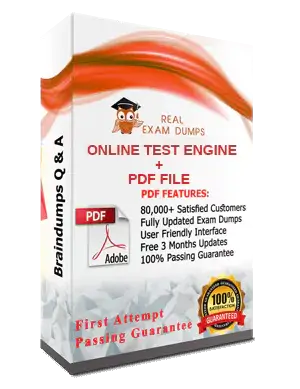DP-100 Exam Dumps

Microsoft DP-100 Dumps - Designing and Implementing a Data Science Solution on Azure PDF Sample Questions

Microsoft DP-100 This Week Result
They can't be wrong
Score in Real Exam at Testing Centre
Questions came word by word from this dumps
Best Microsoft DP-100 Dumps - pass your exam In First Attempt
Our DP-100 dumps are better than all other cheap DP-100 study material.
Only best way to pass your Microsoft DP-100 is that if you will get reliable exam study materials. We ensure you that realexamdumps is one of the most authentic website for Microsoft Microsoft Azure exam question answers. Pass your DP-100 Designing and Implementing a Data Science Solution on Azure with full confidence. You can get free Designing and Implementing a Data Science Solution on Azure demo from realexamdumps. We ensure 100% your success in DP-100 Exam with the help of Microsoft Dumps.You will feel proud to become a part of realexamdumps family.
Our success rate from past 5 year very impressive. Our customers are able to build their carrier in IT field.

 Search
Search
45000+ Exams
 Buy
Buy
Desire Exam
 Download
Download
Exam
Related Exam
Realexamdumps Providing most updated Microsoft Azure Question Answers. Here are a few exams:
Microsoft DP-100 Frequently Asked Questions
Sample Questions
Realexamdumps Providing most updated Microsoft Azure Question Answers. Here are a few sample questions:
Microsoft DP-100 Sample Question 1
You need to select an environment that will meet the business and data requirements. Which environment should you use?
Options:
Answer: E
Microsoft DP-100 Sample Question 2
You need to implement a new cost factor scenario for the ad response models as illustrated in the performance curve exhibit. Which technique should you use?
Options:
Answer: A Explanation: Explanation: Scenario:Performance curves of current and proposed cost factor scenarios are shown in the following diagram:The ad propensity model uses a cut threshold is 0.45 and retrains occur if weighted Kappa deviated from 0.1 +/- 5%.
Microsoft DP-100 Sample Question 3
You need to implement a model development strategy to determine a userâs tendency to respond to an ad. Which technique should you use?
Options:
Answer: A Explanation: Explanation: Split Data partitions the rows of a dataset into two distinct sets.The Relative Expression Split option in the Split Data module of Azure Machine Learning Studio is helpful when you need to divide a dataset into training and testing datasets using a numerical expression.Relative Expression Split: Use this option whenever you want to apply a condition to a number column. The number could be a date/time field, a column containing age or dollar amounts, or even a percentage. For example, you might want to divide your data set depending on the cost of the items, group people by age ranges, or separate data by a calendar date.Scenario:Local market segmentation models will be applied before determining a userâs propensity to respond to an advertisement.The distribution of features across training and production data are not consistentReferences:https://docs.microsoft.com/en-us/azure/machine-learning/studi o-module-reference/split-datb
Microsoft DP-100 Sample Question 4
You need to implement a feature engineering strategy for the crowd sentiment local models. What should you do?
Options:
Answer: D Explanation: Explanation: The linear discriminant analysis method works only on continuous variables, not categorical or ordinal variables.Linear discriminant analysis is similar to analysis of variance (ANOVA) in that it works by comparing the means of the variables.Scenario:Data scientists must build notebooks in a local environment using automatic feature engineering and model building in machine learning pipelines.Experiments for local crowd sentiment models must combine local penalty detection data.All shared features for local models are continuous variables.
Microsoft DP-100 Sample Question 5
You are determining if two sets of data are significantly different from one another by using Azure Machine Learning Studio. Estimated values in one set of data may be more than or less than reference values in the other set of data. You must produce a distribution that has a constant Type I error as a function of the correlation. You need to produce the distribution. Which type of distribution should you produce?
Options:
Answer: A Explanation: Explanation: Choose a one-tail or two-tail test. The default is a two-tailed test. This is the most common type of test, in which the expected distribution is symmetric around zero.Example: Type I error of unpaired and paired two-sample t-tests as a function of the correlation. The simulated random numbers originate from a bivariate normal distribution with a variance of 1.Reference: [Reference:, https://docs.microsoft.com/en-us/azure/machine-learning/studio-module-reference/test-hypothesis-using-t-test, , https://en.wikipedia.org/wiki/Student%27s_t-test, , ]
Microsoft DP-100 Sample Question 6
You use the Azure Machine Learning SDK in a notebook to run an experiment using a script file in an experiment folder. The experiment fails. You need to troubleshoot the failed experiment. What are two possible ways to achieve this goal? Each correct answer presents a complete solution.
Options:
Answer: B, D Explanation: Explanation: Use get_details_with_logs() to fetch the run details and logs created by the run.You can monitor Azure Machine Learning runs and view their logs with the Azure Machine Learning studio.Reference: [Reference:, https://docs.microsoft.com/en-us/python/api/azureml-pipeline-core/azureml.pipeline.core.steprun, , https://docs.microsoft.com/en-us/azure/machine-learning/how-to-monitor-view-training-logs, , , ]
Microsoft DP-100 Sample Question 7
You are conducting feature engineering to prepuce data for further analysis. The data includes seasonal patterns on inventory requirements. You need to select the appropriate method to conduct feature engineering on the data. Which method should you use?
Options:
Answer: E
Microsoft DP-100 Sample Question 8
Note: This question is part of a series of questions that present the same scenario. Each question in the series contains a unique solution that might meet the stated goals. Some question sets might have more than one correct solution, while others might not have a correct solution. After you answer a question in this section, you will NOT be able to return to it. As a result, these questions will not appear in the review screen. You are creating a model to predict the price of a studentâs artwork depending on the following variables: the studentâs length of education, degree type, and art form. You start by creating a linear regression model. You need to evaluate the linear regression model. Solution: Use the following metrics: Accuracy, Precision, Recall, F1 score and AUC. Does the solution meet the goal?
Options:
Answer: B Explanation: Explanation: Those are metrics for evaluating classification models, instead use: Mean Absolute Error, Root Mean Absolute Error, Relative Absolute Error, Relative Squared Error, and the Coefficient of Determination.References:https://docs.microsoft.com/en-us/azure/machine-learning/studio-module-reference/evaluate-modem
Microsoft DP-100 Sample Question 9
You create an Azure Machine Learning compute resource to train models. The compute resource is configured as follows: You must decrease the minimum number of nodes and increase the maximum number of nodes to the following values: You need to reconfigure the compute resource. What are three possible ways to achieve this goal? Each correct answer presents a complete solution. NOTE: Each correct selection is worth one point.
Options:
Answer: A, B, C Explanation: Reference: [Reference:, https://docs.microsoft.com/en-us/python/api/azureml-core/azureml.core.compute.amlcompute(class), , , , ]
Microsoft DP-100 Sample Question 10
You create a machine learning model by using the Azure Machine Learning designer. You publish the model as a real-time service on an Azure Kubernetes Service (AKS) inference compute cluster. You make no changes to the deployed endpoint configuration. You need to provide application developers with the information they need to consume the endpoint. Which two values should you provide to application developers? Each correct answer presents part of the solution. NOTE: Each correct selection is worth one point.
Options:
Answer: C, E Explanation: Explanation: Deploying an Azure Machine Learning model as a web service creates a REST API endpoint. You can send data to this endpoint and receive the prediction returned by the model.You create a web service when you deploy a model to your local environment, Azure Container Instances, Azure Kubernetes Service, or field-programmable gate arrays (FPGA). You retrieve the URI used to access the web service by using the Azure Machine Learning SDK. If authentication is enabled, you can also use the SDK to get the authentication keys or tokens.Example:# URL for the web servicescoring_uri = '# If the service is authenticated, set the key or tokenkey = 'Reference: [Reference:, https://docs.microsoft.com/en-us/azure/machine-learning/how-to-consume-web-service, , , , ]

